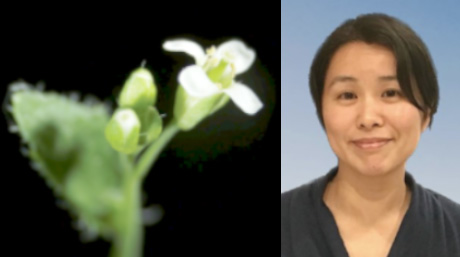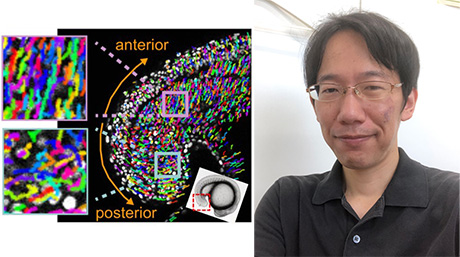Life Science and Technology News
【Labs spotlight】 Miyashita Laboratory
Explore the brain to understand adaptive control mechanisms of the arm
The Department has a variety of laboratories for Human Centered Science and Biomedical Engineering, in which cutting-edge innovative research is being undertaken not only in basic science and engineering but also in the areas of medicine, pharmacy, agriculture, and multidisciplinary sciences.
This "Spotlight" series features a laboratory from the Department and introduces you to the laboratory's research projects and outcomes. This time we focus on Miyashita Laboratory.
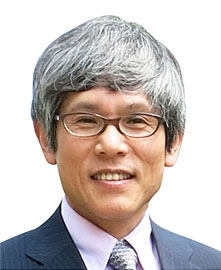
Areas of Supervision
Primary/Science and Technology for health Care and Medicine
Secondary/Life Science and Technology, Human Centered Science and Biomedical Engineering
Associate Professor Eizo Miyashita![]()
| Degree |
MD 1985, Wakayama Medical College PhD 1990, Wakayama Medical College |
|---|---|
| Areas of Research | Neural mechanisms of adaptive control of arm movements, eye-hand coordination, information decoding from population neural activity |
| Keywords | Systems Neuroscience, Behavior, Reaching Movement, Motor Learning, Neural Code |
Research interest
Brain regions that concern execution of arm movements and motor learning
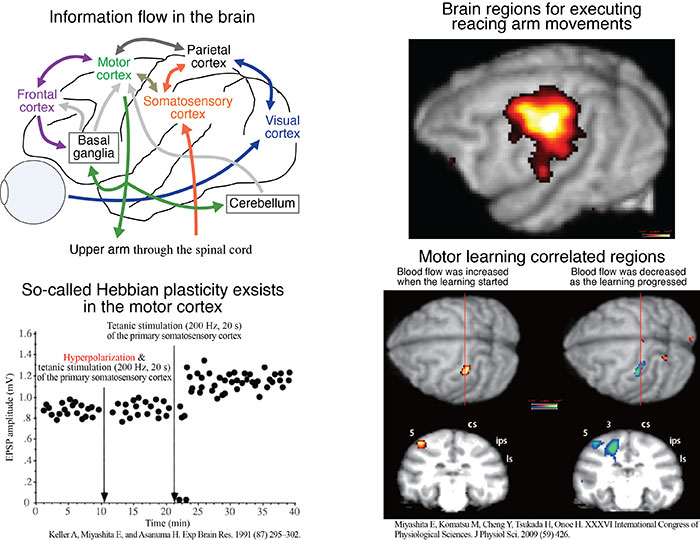
Thanks to accumulating knowledge of functional anatomy about the brain, it has been possible to presume the flow of information regarding arm movements within it. Now, a question will arise; which regions of the brain concern execution of the movement? Positron emission tomography (PET: SHR-7700, Hamamatsu Photonics) was employed to answer the question. As expected, parts of the motor cortex, somatosensory cortex, and parietal cortex were activated.
When I worked with Dr. Hiroshi Asanuma at the Rockefeller University, we found so-called Hebbian plasticity in neurons of the motor cortex that received synaptic input from the somatosensory cortex. To reveal the function of these plasticity, we tentatively tried to identify brain regions using PET which amount of activity was changed relating to motor learning. Interestingly, a part of the parietal cortex, which was correlated activation with execution of the movement, showed increased activity after the learning started and gradually decreased activity as the learning progressed. What is the functional role of this region, do you think?
Modeling the control of arm movements by the brain
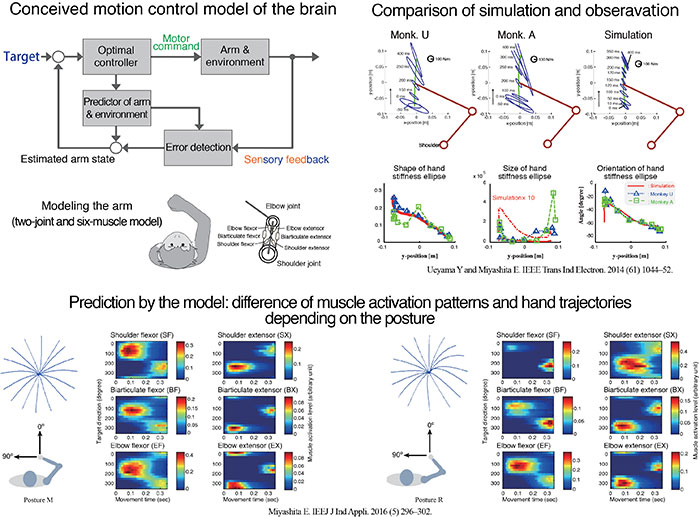
How the brain controls the arm? I conceive that modern control theory will help us to understand it. In this framework, the product of estimated state of the arm and a feedback gain generates motor command. State predictor of the arm predicts the state of it using the motor command, and a plausible state is estimated depending on the error of the predicted state and observed state.
Simulation experiments demonstrated that a control model based on the modern control theory was able to fairly reproduce the characteristics (except the size) of measured stiffness ellipse of the hand during reaching movements in the horizontal plane. The model predicted that a hand trajectory varied from nearly straight to moderately curved depending on the start position and movement direction. Imagine how to draw a straight line without a ruler.
Information representation of arm movements in the brain
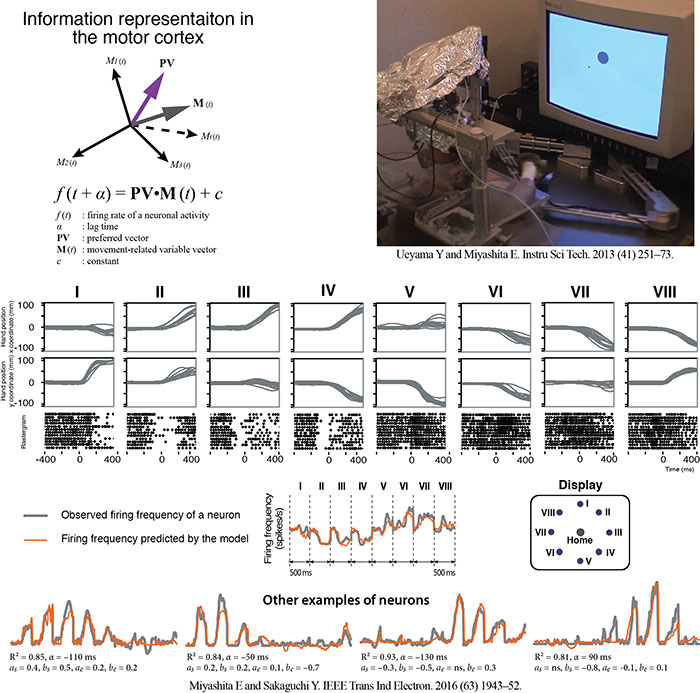
Although the final goal is to understand how the brain executes what kind of computation, we are trying to reveal what kind of movement related information is encoded as activity of neuron in the motor cortex as a tentative goal.
As far as encoding on single neuronal activity concerned, it is possible to conceive that some movement variables correlated with arm movements are encoded on neuronal activity as the dot product of the movement variables vector and a vector defined in the variable space (PV: preferred vector), which characterize the activity of a neuron.
We have reported that joint torques and joint angular velocities of the arm are able to explain major variability of activity of many neurons in the motor cortex during arm movements in the horizontal plane.
Ongoing projects
Integration mechanism of eye and arm movements, neural mechanism of motor learning, information decoding from population activity of neurons, etc.
Research findings
Selected publications
Journal papers
- [1] Miyashita E (2016), Understanding Motion Control of the Body Using Optimal Feedback Control, IEEJ Journal of Industry Applications 5 (5): 296-302.
- [2] Miyashita E & Sakaguchi Y (2016), State variables of the arm may be encoded by single neuron activity in the monkey motor cortex, IEEE Transactions on Industrial Electronics 63 (3): 1943-52
- [3] Ueyama Y & Miyashita E (2014), Optimal feedback control for predicting dynamic stiffness during arm movement, IEEE Transactions on Industrial Electronics 61 (2): 1044-1052
- [4] Ueyama Y & Miyashita E (2013), Devising a robotic arm manipulandum for normal and altered reaching movements to investigate brain mechanisms of motor control, Instrumentation Science & Technology 41: 251-273
- [5] Ueyama Y & Miyashita E (2013), Signal-dependent noise induces muscle co-contraction to achieve required movement accuracy: a simulation study with an optimal control, Current Bioinformatics 5: 16-24
- [6] Ueyama Y & Miyashita E (2012), Estimation of visual feedback contribution to limb stiffness in visuomotor control, Brain Informatics Lecture Notes in Computer Science 7670: 61-72
- [7] Komatsu M & Miyashita E (2010), Representation of a memorized target in allocentric coordinates, Australian Journal of Intelligent Information Processsing Systems 12: 41-45
International congress papers with review
- [1] Miyashita E & Sakaguchi Y (2014), Suggestive evidence for a forward model of the arm in the monkey motor cortex, Proceedings of IEEE 13th International Workshop on Advanced Motion Control, P. 191-196
- [2] Ueyama Y & Miyashita E (2012), A numerical simulation using optimal control can estimate stiffness profiles of a monkey arm during reaching movements, Proceedings of 12th IEEE International Workshop on Advanced Motion Control, P. 1-6
- [3] Ueyama Y & Miyashita E (2011), Cocontraction of pairs of muscles around joints may improve an accuracy of a reaching movement: a numerical simulation study, Proceedings of 2011 International Symposium on Computational Models for Life Sciences, P. 73-82
Contact
Associate Professor Eizo Miyashita
Room 1114, G3 building, Suzukakedai campus
E-mail : miyashita.e.aa@m.titech.ac.jp
*Find more about the lab and the latest activities at the laboratory.
*May 1, 2025:Some of the content has been updated with the latest information.



